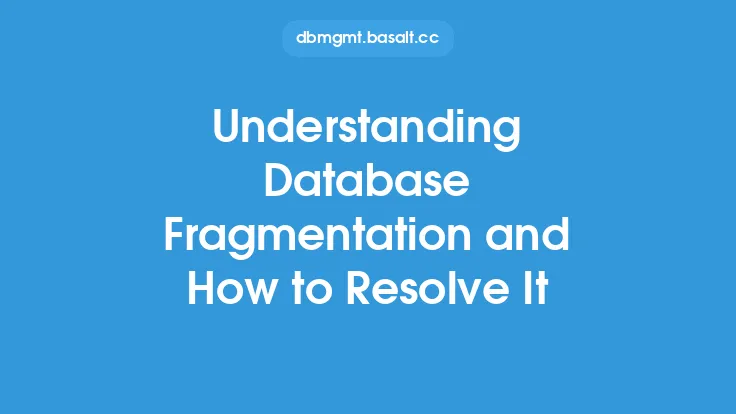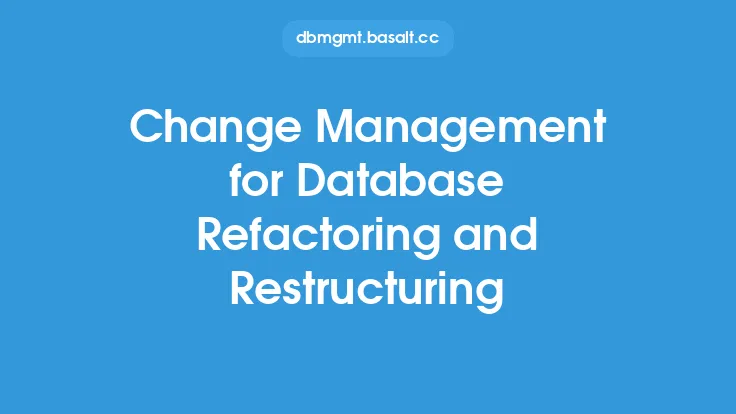Database schema refactoring is an essential process in database management that involves modifying the existing database structure to improve its performance, scalability, and maintainability. As databases evolve over time, their schemas can become outdated, leading to inefficiencies, data inconsistencies, and difficulties in adapting to changing business requirements. Refactoring a database schema can help address these issues, but it requires careful planning, execution, and testing to ensure minimal disruption to the application and data.
Introduction to Database Schema Refactoring
Database schema refactoring is a complex process that involves analyzing the existing database structure, identifying areas for improvement, and applying changes to the schema to achieve the desired outcomes. The process typically involves a series of steps, including analysis, design, implementation, testing, and deployment. Refactoring a database schema can be a time-consuming and resource-intensive process, but it can have significant benefits, such as improved data integrity, reduced data redundancy, and enhanced query performance.
When to Refactor a Database Schema
There are several scenarios in which refactoring a database schema may be necessary. One common scenario is when the database has undergone significant changes in its data structure or volume, leading to performance issues or data inconsistencies. For example, if a database has grown significantly in size, its schema may need to be refactored to optimize query performance or to reduce data redundancy. Another scenario is when the database is being migrated to a new platform or technology, requiring changes to the schema to ensure compatibility. Additionally, refactoring a database schema may be necessary when the business requirements of the application have changed, requiring modifications to the data structure to support new features or functionality.
How to Refactor a Database Schema
Refactoring a database schema involves several steps, including analysis, design, implementation, testing, and deployment. The first step is to analyze the existing database structure, identifying areas for improvement and potential bottlenecks. This involves reviewing the database schema, analyzing query performance, and identifying data inconsistencies or redundancies. The next step is to design a new schema that addresses the identified issues, taking into account the business requirements of the application and the technical constraints of the database platform. The new schema should be optimized for performance, scalability, and maintainability, and should ensure data integrity and consistency.
Database Schema Refactoring Techniques
There are several techniques that can be used to refactor a database schema, including table splitting, table merging, and data type changes. Table splitting involves dividing a large table into smaller tables to improve query performance and reduce data redundancy. Table merging involves combining multiple tables into a single table to reduce data redundancy and improve data consistency. Data type changes involve modifying the data type of a column to improve data integrity and reduce storage requirements. Other techniques include indexing, partitioning, and denormalization, which can be used to improve query performance and reduce data redundancy.
Best Practices for Database Schema Refactoring
There are several best practices that should be followed when refactoring a database schema. One best practice is to thoroughly analyze the existing database structure and identify areas for improvement before making any changes. Another best practice is to design a new schema that is optimized for performance, scalability, and maintainability, and that ensures data integrity and consistency. It is also essential to test the new schema thoroughly before deploying it to production, to ensure that it meets the business requirements of the application and does not introduce any new issues. Additionally, it is recommended to refactor the database schema in small, incremental steps, to minimize disruption to the application and data.
Tools and Technologies for Database Schema Refactoring
There are several tools and technologies that can be used to refactor a database schema, including database management systems, schema migration tools, and data modeling tools. Database management systems, such as MySQL and Oracle, provide built-in tools and features for refactoring database schemas, including data type changes, indexing, and partitioning. Schema migration tools, such as Flyway and Liquibase, provide a structured approach to refactoring database schemas, allowing developers to manage changes to the schema in a controlled and predictable manner. Data modeling tools, such as Entity-Relationship diagrams and Object-Relational mapping tools, can be used to design and optimize database schemas, and to identify areas for improvement.
Challenges and Risks of Database Schema Refactoring
Refactoring a database schema can be a complex and challenging process, and there are several risks and challenges that should be considered. One challenge is ensuring data integrity and consistency during the refactoring process, to prevent data loss or corruption. Another challenge is minimizing disruption to the application and data, to ensure that the refactoring process does not impact business operations. Additionally, refactoring a database schema can be a time-consuming and resource-intensive process, requiring significant planning, testing, and deployment efforts. It is essential to carefully plan and execute the refactoring process, to ensure that it is successful and meets the business requirements of the application.
Conclusion
Database schema refactoring is an essential process in database management that involves modifying the existing database structure to improve its performance, scalability, and maintainability. By following best practices, using the right tools and technologies, and carefully planning and executing the refactoring process, developers can ensure that their database schemas are optimized for performance, scalability, and maintainability, and that they meet the evolving business requirements of their applications. Whether it's to improve query performance, reduce data redundancy, or enhance data integrity, refactoring a database schema can have significant benefits, and is an important aspect of database management and maintenance.





